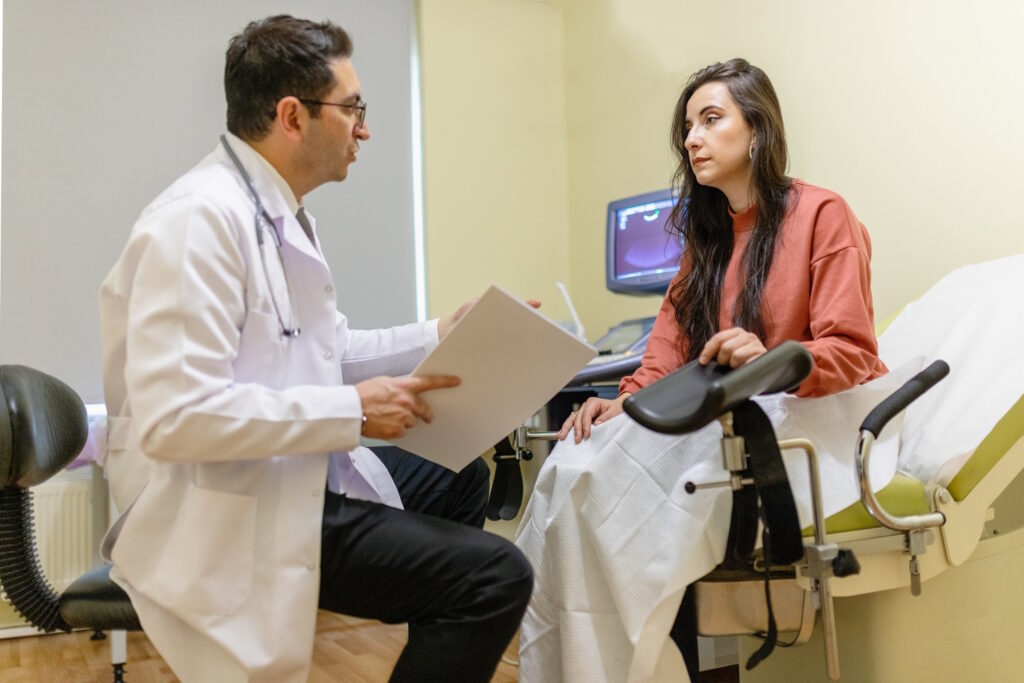When Selma* was diagnosed with fibroids, one of the first things she did was let out a deep sigh of relief. Firstly, she finally had a diagnosis to explain the heavy bleeding, extended tummy, abdominal pressure, urinary frequency, and other period problems. Secondly, since fibroids are benign growths that develop from the muscle tissue in the uterus, there’s no concern about cancer. Right? Well, just as Selma was starting to relax, her gynecologist ordered a biopsy—a test used to determine if certain tissue is cancerous. Needless to say, Selma began to internally second-guess everything she thought she knew and became very worried. She wondered, “If fibroids aren’t cancerous, why did my gynecologist order a biopsy?”
This is a common question fibroid patients ask. And if you search online, you will likely find more than a handful of forums and chats dominated by similar discussions and questions. “Why would there be a concern?” “Why did my gynecologist order a biopsy?” “Why would they recommend a hysterectomy or myomectomy for fibroid removal if there’s no risk?” Almost all these women are petrified by the mere mention of a biopsy, leading them to believe fibroids are cancerous. But this couldn’t be further from the truth.
The Real Truth About Fibroids
Uterine fibroids, also called leiomyomas (lie-o-my-O-muhs), are noncancerous growths of the uterus. Many women get them, and the majority are diagnosed in women between the ages of 35 and 54. You may have one fibroid or many in differing sizes, which can grow slowly or quickly. They can also stay the same size. With fibroids, you may have painful and debilitating symptoms that make it hard for you to carry on with your normal day-to-day activities.
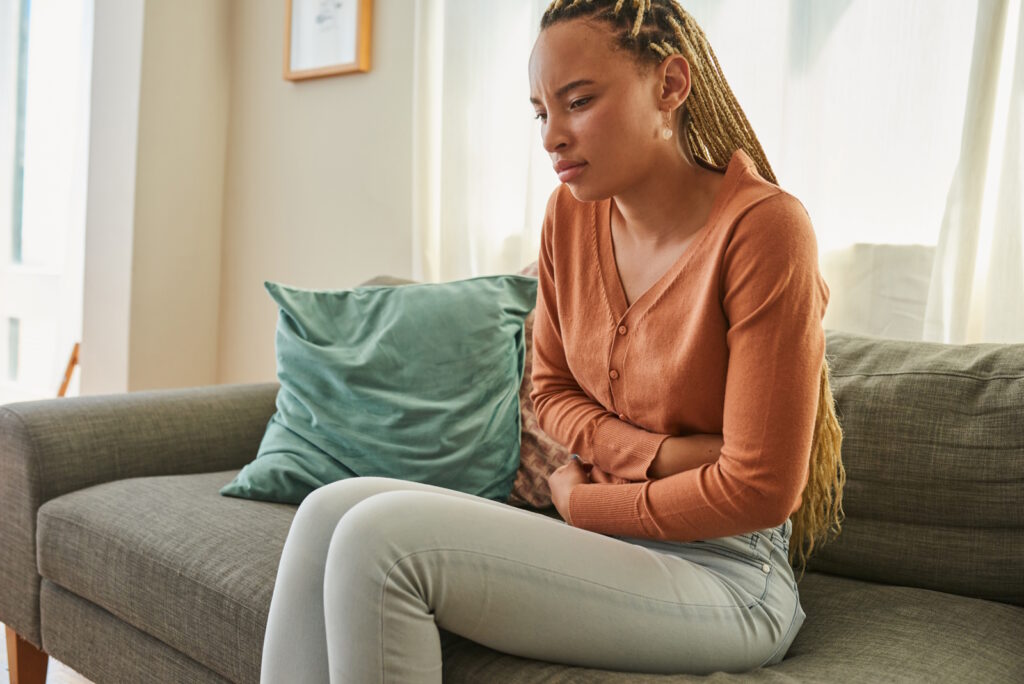
Fibroid symptoms may include:
- Painful periods, including heavy or inconsistent menstrual bleeding
- Debilitating cramps, pelvic pain, and pressure
- Pain during sexual intercourse
- Bloating or swelling in the lower abdomen
- Back or leg pain
- An urge to urinate
- Constipation, diarrhea, and rectal discomfort
- Anemia, which can lead to fatigue
Fibroids are so common that if you have several fibroid symptoms, your chance of having one or more uterine fibroids is high. To know for certain, your doctor or gynecologist will conduct a few tests to find out.
Here are three common diagnostic methods:
- Physical exam – Your doctor may notice if you have fibroids during a routine pelvic exam by gently pressing on your pelvis with their hands to explore the region. Fibroids often cause the uterus to become larger, so depending on your situation, your doctor might even be able to feel the fibroids.
- Ultrasound – Beyond a pelvic exam, the next step is usually an ultrasound. This form of imaging uses sound waves to take a picture of your uterus, either by moving a device across your abdomen or inserting it into your vagina. An ultrasound helps your doctor determine if you have fibroids and the approximate size of each one.
- MRI – An MRI is the best imaging technique because it provides the most information. An MRI shows fibroids that are not visible on ultrasound. Pelvic MRI provides the most detail in terms of the number, size, and exact location of all fibroids in the uterus. It can also show other potential sources of your symptoms and give the doctor a better idea of which treatment is best.
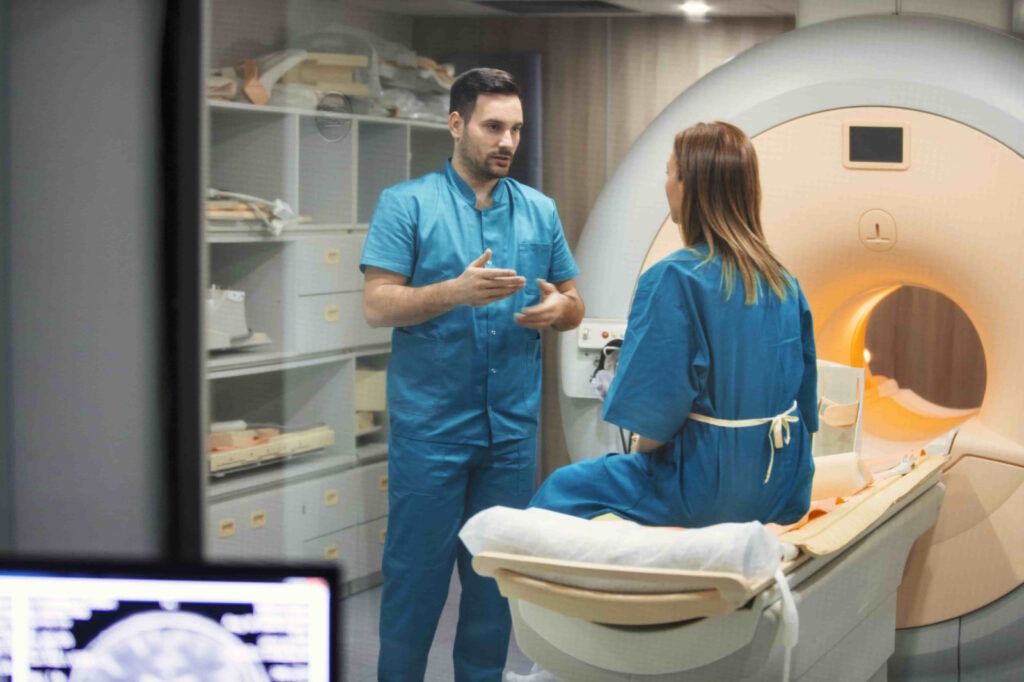
To think Fibroid Tumors are cancerous is understandable since fibroids are tumors, and most people assume tumors are cancerous. But take it from a team of interventional radiologists who specialize in fibroids (we’ve devoted our practice and career to helping women live fibroid free), most fibroids are benign or noncancerous. In fact, the Office on Women’s Health says that less than one in 1,000 cases involve a cancerous fibroid. Furthermore, having fibroids does not increase the risk of developing cancerous fibroids.
So Why Did My Gynecologist Order a Biopsy?
It is understandably scary when your gynecologist orders a biopsy. This is especially true when all you’ve heard is that fibroids aren’t cancerous. But just because they order one does not mean you have cancer. It also doesn’t mean that your fibroids are cancerous or could become cancerous. Biopsies simply confirm the initial diagnosis and whether abnormalities in your body are caused by cancer or other conditions.
Biopsies can also distinguish between fibroids and cancerous tumors that may look like uterine fibroids. Two female-specific cancers worth discussing are endometrial cancer and uterine sarcoma.
Uterine Sarcoma
This is when malignant cancer cells form in or around the muscles of the uterus. Sarcomas can be misdiagnosed as uterine fibroids and share similar symptoms such as bleeding that is not part of menstrual periods, frequent urination, and pain or a feeling of fullness in the abdomen. But this form of cancer is extremely rare, affecting about 5,000 people in the United States each year. The bottom line is there is no link between uterine sarcoma and fibroids. Even if you have undiagnosed fibroids for years, they don’t progress to sarcoma.
Endometrial Cancer
Also called uterine cancer, this form of cancer is different from sarcoma in that it develops in the tissue that lines the uterus. Roughly 50,000 American women are diagnosed with this disease every year, making it the most common form of uterine cancer. It also displays some of the same symptoms as fibroids (bleeding between periods and pelvic pain, for example).
So, to answer the question, “why did my gynecologist order a biopsy?” it is because they want to confirm that their initial diagnosis is accurate—even if they have all the evidence in place that you have fibroids.
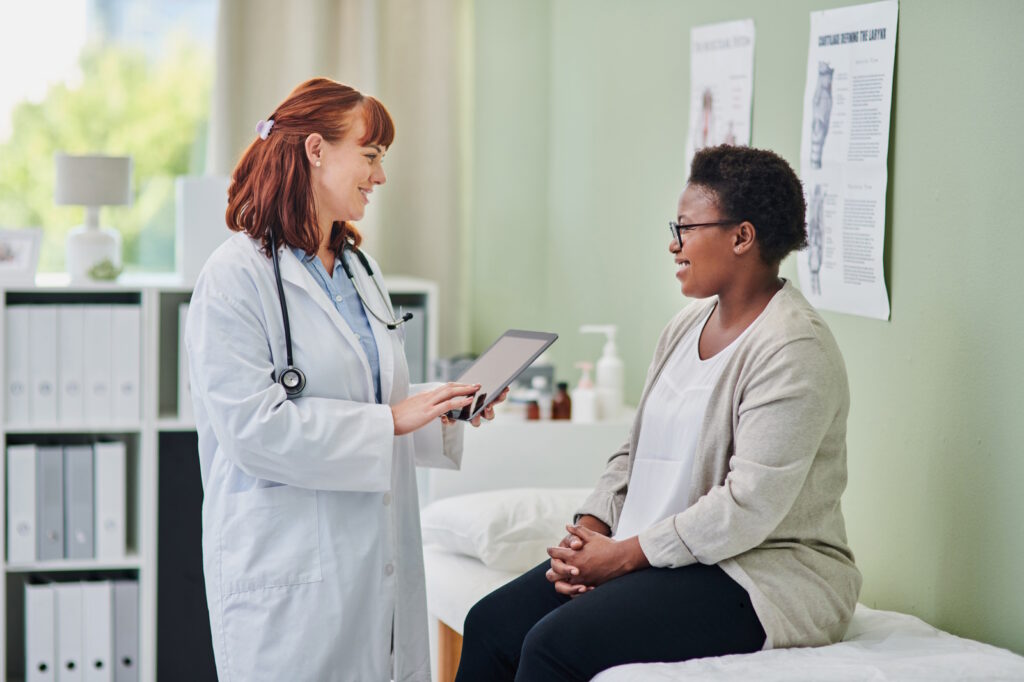
Is Surgery My Only Option for Fibroid Removal?
Even if it is determined that you do have fibroids and not cancer, a gynecologist might suggest surgeries such as hysterectomy and myomectomy rather than less invasive treatment options such as uterine fibroid embolization (UFE). This decision can be made for several reasons, including a lack of experience with UFE, misinformation about UFE and its benefits, and a doctor’s specialty in fibroid surgery as opposed to other minimally invasive options. But also, some doctors believe fibroid surgery—though invasive—eliminates the 1% chance that your fibroids could be cancerous. Not to mention, hysterectomy and myomectomy are the preferred options for women with uterine cancer.
A hysterectomy removes all or part of a woman’s uterus and, in some cases, the fallopian tubes and ovaries. It takes a longer time to heal from a hysterectomy than other methods. How fast you recover depends on the type of hysterectomy surgery. A hysterectomy is a way to treat fibroids because everywhere they could possibly grow in your uterus, has now been removed.
With a myomectomy, the goal is to remove only the symptom-causing fibroids to preserve the uterus. Depending on how many fibroids need to be removed, your doctor will surgically reconstruct the uterus to ensure its viability long term. This is preferred by women who aren’t ready to have their entire uterus and, in some cases, fallopian tubes and ovaries, removed by way of a hysterectomy.
Many women don’t realize there are less invasive options outside of a hysterectomy or myomectomy.
What Is UFE – Uterine Fibroid Embolization?
UFE is unique because it treats fibroids without painful surgery and a lengthy recovery. The UFE procedure is a minimally invasive fibroid treatment that stops the blood flow to the fibroids. Using image-guided interventional radiology, experienced fibroid doctors at Fibroid Institute insert a tiny catheter through a small nick in the wrist. Small particles are introduced through the catheter to the fibroid vessels, forming a barrier to the fibroids’ blood supply. As a result, fibroids shrink and die, greatly reducing or eliminating symptoms so that you can get back to normal activities quickly.
Just a few additional advantages of UFE at Fibroid Institute include:
- Covered by most medical insurance
- No hospital stay
- Shorter recovery period (one week in some cases)
- No scarring
- Uterus is spared
- Treat multiple fibroids at once
- Dramatic reduction in fibroid symptoms
- Over 90% effective
- Doctors are 100% focused helping women with fibroids
Patient-Centered Care, from Consult to Pre-Authorizations to Follow Ups
We understand that you may have questions and concerns after your gynecologist orders a biopsy. After all, what else are you supposed to think when all you’ve ever heard is that fibroids are noncancerous? We are here to tell you that while there is a 1% chance your unique situation is cancerous, fibroids are almost always benign. And invasive surgeries like hysterectomy are no longer the only option on the table.
At Fibroid Institute, we are dedicated to educating and empowering women on fibroid treatment options. With multiple locations in Dallas and Houston, our fibroid clinics help thousands of women find relief from their fibroid symptoms. Our fibroid doctors are board-certified interventional radiologists and experts who are passionate about helping women become #FibroidFree. Dr. John Fischer and Dr. Suzanne Slonim are among the most experienced fibroid specialists 100% focused on fibroid treatment in the Dallas and Houston metro areas.
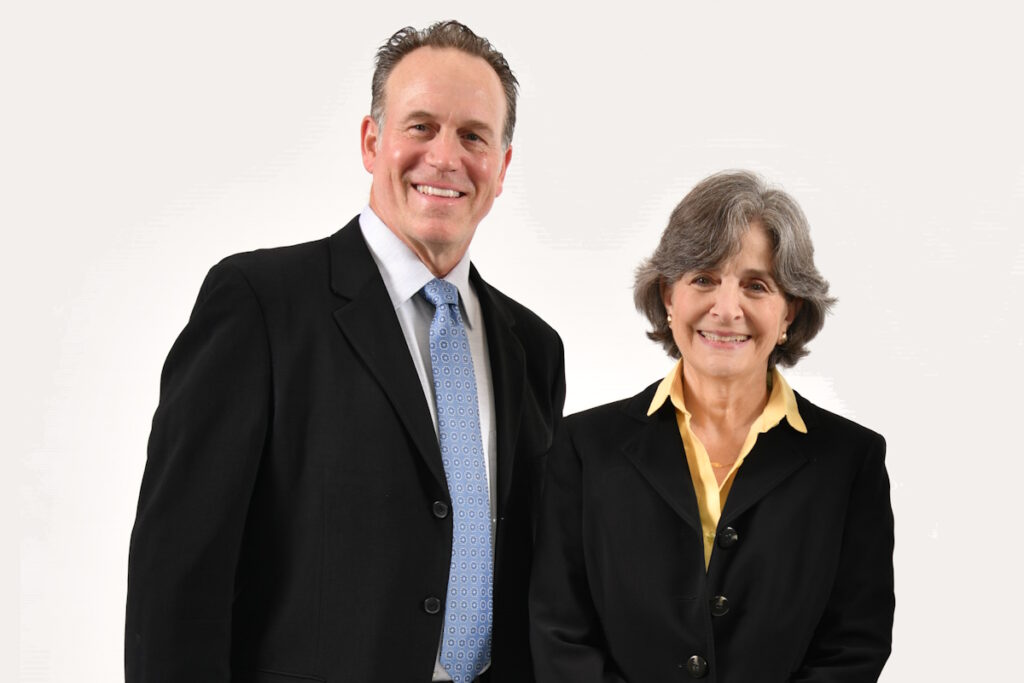
Find out if you are a candidate for UFE. Call for a telehealth consult or an in-office appointment at our Dallas fibroid clinics at 214-838-6440, Houston fibroid clinics at 713-903-3733, or complete the form below.
"*" indicates required fields
Prior to starting any new treatment or if you have questions regarding a medical condition, always seek the advice of your doctor or other qualified health provider. This information is not a substitute for professional medical advice.
Fibroid Institute Texas serves the Dallas and Houston areas including Addison, Carrollton, Plano, Frisco, Craig Ranch, McKinney, Allen, Fort Worth, Grand Prairie, HEB, Arlington, Hutchins, Irving, Duncanville, DeSoto, Cedar Hill, Lancaster, Cockrell Hill, Highland Park, University Park, Park Cities, Garland, Mesquite, Richardson, Dallas, Sherman, Houston, Sugar Land, Katy, Webster, Clear Lake, The Woodlands, Universal City, Spring, Kingwood, Stafford, Conroe, Texas City, Cypress, League City, Bellaire, and more.
*Patient stories are true. Names and/or photos may be changed to protect patient confidentiality.

